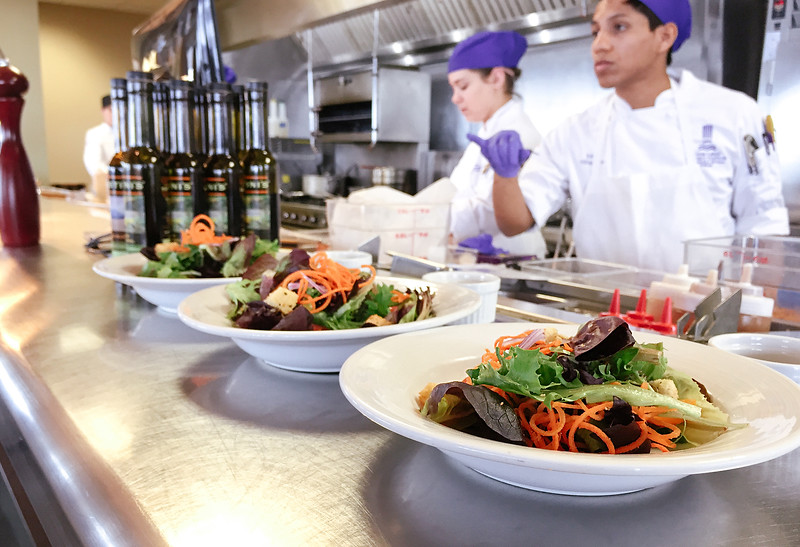
Out of the Frying Pan, Out of the Fire
How NMC’s Great Lakes Culinary Institute came back from the brink of oblivion
By Craig Manning | Feb. 17, 2024
Two years ago, the Great Lakes Culinary Institute (GLCI) was a massive money-losing operation for Northwestern Michigan College (NMC)—to the point where the college was questioning whether the beloved-but-expensive program should be eliminated entirely.
Instead, NMC doubled down on GLCI, reimagining the program for a more modern context, looking for opportunities to cut costs, and chasing down heretofore-untapped revenue streams. Fast-forward to 2024, and the program that was once running at a deficit of $375,000 is now on the verge of breaking even.
In this week’s Northern Express, we take a look at how GLCI turned the plane around—and at what the future may hold for culinary education in northern Michigan now that the program appears to be here to stay.
The Night Is Darkest Just Before the Dawn
Speaking to Northern Express sister publication The Ticker at the start of the 2022-23 academic year, NMC President Nick Nissley was candid about how GLCI had fallen upon hard times.
“We were looking at program assessments across the college, which we do periodically to ask how we’re doing,” Nissley explained. “And as we looked at the culinary program, a couple of things struck us. Number one, we’ve seen a decline in enrollment over the last decade. Back in 2014, we were at over 200 students; in 2022, that was down to about 80. And linked to that, our revenue [from GLCI] was halved in that time. In 2014, we were up to almost $600,000 in revenue; in 2022, we were down to about $300,000. For me, those were warning bells saying that we needed to take action.”
Subsequent consulting sessions with the Culinary Institute of America—a New York-based institution that Nissley described as “the gold standard of culinary education”—highlighted just how dire the situation was.
“A really positive thing they told us was that any culinary program in the country will typically run at a deficit,” Nissley said of those consulting sessions. “In a college setting, a culinary program is almost always being funded by other programs, because culinary programs are so capital and labor intensive.” Even with that caveat, though, the consultants flagged GLCI’s sizable and quickly-growing deficit—$360,000 in 2022, compared to $60,000 in 2014—as a downright existential problem.
“[The Culinary Institute] ultimately came back with some really harsh news for us,” Nissley said. “They told us that all indicators suggested that the program should be closed.”
Righting the Ship
While retiring GLCI might have been logical from a dollars and cents perspective, NMC leadership ultimately decided that the program—even as a money loser—was important to the college’s identity and to the Traverse City community as a whole. And so, the question internally at NMC became: How can the culinary program evolve so that, even if it’s still losing money, it’s losing less money?
So says Jason Slade, NMC’s vice president for strategic initiatives. Per Slade, when NMC was running baseline numbers for GLCI ahead of the reimagining process, the program was “$375,000 in the hole.”
“Our goal for them was just to lose less than $150,000,” Slade says.
In pursuit of that goal, NMC and GLCI made a few key changes. One step was slimming down the program’s staff, which was still calibrated to peak enrollment and revenue numbers from 2014. Another was subverting NMC’s standard 15-week semester structure; instead, GLCI classes now break down into shorter eight-week terms, which helps make them more approachable and accessible for students who need to juggle work, family, and other obligations along with their school commitments.
GLCI has also added new programming to its slate. The core GLCI curriculum now boasts several fresh course subjects—from plated desserts, to farm-to-table dining, to beverage management. GLCI has also created a variety of shorter-form culinary certificates, including one specializing in baking and pastry skills and another designed to train students to be chefs on maritime vessels. In the fall, NMC will add another culinary certificate to the equation, this one focusing on sports performance nutrition.
According to GLCI Director Les Eckert, the new courses and certificates are all the result of emerging industry demands.
“When we start hearing a lot about a trend or a need out in the culinary industry, we evaluate the gap and our ability to close the gap,” Eckert explains. “And if we see that we can indeed help with the training to close that gap, that’s when we start looking at how we can create a new course or certificate.”
For example, on the subject of GLCI’s forthcoming sports performance nutrition certificate, Eckert points to a growing demand in the world of professional sports for chefs who are specifically trained in designing menus and preparing meals based on the dietary needs of elite athletes.
“This certificate would help a chef work with, say, a dietician or nutritionist to create menus and recipes, not only for sports teams but also for individual athletes, maybe even as a private chef,” Eckert says. “A lot of sports teams, both professional and collegiate, already have dieticians and nutritionists to help with pre-game and post-game training, or with bulking or cutting, or with whatever the athletes are trying to do. But they want their own chefs, too. This certificate will help address that industry demand.”
Other factors are helping drive new revenue to GLCI, too, including open-to-the-public master classes and a growing focus on selling student-made goods at NMC’s Hawk Owl Café.
Almost Out of the Hole
So far, the changes at GLCI seem to be working.
“This past fall, GLCI had a head count of 87,” Slade says. “The baseline year, enrollment was 76; last year, it was 74. So, that’s an 18 percent increase that we had in terms of headcount of students. In turn, that drives contact hours, and contact hours are how students pay for classes, and how we assign faculty load, and all these important things. So, there’s no doubt the GLCI is rebounding.”
Most notably, Slade says GLCI is significantly outperforming the college’s original goals.
“As of June 2023, they only had a net loss of $27,000,” he notes. “Now, the program is still losing money, but recall that our goal for them was just to lose less than $150,000. So, really, they absolutely killed it last year. I just ran the numbers [for 2023-24], and I actually have GLCI on track to break even this academic year.”
For her part, Eckert is pleased to see the changes doing what they were supposed to do, but isn’t ready yet to take her foot off the gas pedal just yet.
“Even though we see the deficit now shrinking and going away, we can’t get too excited,” she says. “We can’t just say, ‘Oh, we did it, we saved the program,’ and then forget about this work that we did. And that’s the scary thing, because our team hasn’t only been on for the last year and a half, we’ve been on at about 300 percent. Can we slow down and just be on at 150 percent? I don’t know! I’m a little nervous to say, yes, we can back down a little bit.”
Eckert’s goal now is to solidify GLCI as a program that can thrive sustainably for years to come. One potential lever NMC could still pull to take GLCI revenues to an even higher level? An evolution of Lobdell’s, the program’s Hagerty Center-based teaching restaurant.
Last year, NMC hired a revenue enhancement consultant to take a closer look at GLCI—and specifically at Lobdell’s—and to identify potential opportunities to maximize the restaurant’s impact on the college’s bottom line.
“[The consultant] did have a recommendation for more of a full-fledged restaurant in the Lobdell’s space,” Slade says. “We’re not dismissing that idea, but we need to figure out our Lobdell’s usage, because we’d need to be doing two things in tandem. One, we’re ramping up these academic classes, which means Lobdell’s is being used more often by GLCI. If we’re running a full-fledged restaurant there, we have to make sure that we don’t displace our students from that experience. So, we’re currently getting a feel for what Lobdell’s looks like with the new numbers [for GLCI enrollment], and then we’ll go from there.”
Trending

Walking in an Artsy Wonderland
Michigan Legacy Art Park is hosting the “Raindrops” artwork created by Dewey Blocksma and Patricia Innis at th... Read More >>
Seven Takeaways from Local Real Estate Agents for the Spring/Summer Market
The last few years in local real estate have been akin to what one local agent described as the “wild west,” w... Read More >>
Blazing the Boyne City to Charlevoix Trail
We’re getting ever closer to an interconnected northern Michigan thanks to ongoing work on the Boyne City to Charlev... Read More >>


